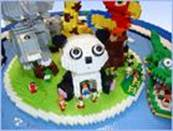题目内容
Growers around the world are using new methods to grow grapes to make wine. They use natural and organic methods to control harmful insects and weeds instead of using chemicals. Now, a winery in Canada has adopted a natural way to control its grapevines (葡萄藤).The Featherstone Winery is in southern Ontario. The grapevines, like other plants, need to be cut every year.
Cutting grapevines must be done very carefully. Only a targeted area of leaves is removed from the lower part of the vines to help the grapes grow better. But at the Featherstone Winery, no man or machine does the cutting. Instead, the job is done by 40 little wooly lambs.www.zxxk.com
David Johnson owns the vineyard. He says he learned about using lambs while visiting wineries in New Zealand. The young lambs are perfectly designed to do the job. They eat the grape leaves on the lower parts of the vine. But they are not tall enough to reach the grapes. They only weigh about 22 kilograms, so they do not beat down the soil. And their waste makes good organic fertilizer. In addition, using the lambs costs much less than hiring workers to cut the vines for seven weeks in summer. And when the cutting is done in August, the lambs become tasty dishes.
Mr Johnson says he had a difficult time finding enough lambs to do the job. There are about 50 million lambs in New Zealand. But there are not nearly as many in Ontario. Also, some organic pesticides (杀虫剂) are harmful to lambs. And the lambs must be watched to make sure they do not eat too much of the grapevines.
David Johnson says the lambs help him carry out his environmental ideas about farming. They are lovely and peaceful and he likes having them in his vineyard. People visiting the vineyard also enjoy watching the lambs do their job
- 1.
Farmers who grow grapes with natural and organic methods _____
- A.don't cut grapevines every year
- B.don't use chemicals to control harmful insects and weeds
- C.don't need to control harmful insects and weeds
- D.don't use organic fertilizer
- A.
- 2.
In order to help the grapes grow better, growers _____
- A.only have to remove the dead leaves
- B.need to remove a specific area of leaves
- C.shouldn't remove any part of the plants
- D.should let little lambs do the cutting
- A.
- 3.
Paragraph 4 is mainly about _____
- A.the future of getting lambs to do the cutting
- B.the worries about using organic pesticides
- C.the ways to get lambs to do the cutting
- D.the problems related to lambs doing the cutting
- A.
- 4.
We can infer from the passage that David Johnson______
- A.owns several wineries in Canada
- B.buys lambs from New Zealand
- C.is concerned about protecting the environment
- D.loves keeping lambs instead of farming
- A.
BBDC
试题分析:本文在采用环保的方式来种植葡萄酿酒。
1.B细节题 从第一段They use natural and organic methods to control harmful insects and weeds instead of using chemicals中找到答案B是正确的。
2.B推断题,从第二段Only a targeted area of leaves is removed from the lower part of the vines to help the grapes grow better推断出答案B项。
3.D 段落大意 从第四段第一句话推断出D项
4.C推断题 从最后一段第一句话推断出David Johnson是个环保人士
考点 环保类阅读
试题分析:本文在采用环保的方式来种植葡萄酿酒。
1.B细节题 从第一段They use natural and organic methods to control harmful insects and weeds instead of using chemicals中找到答案B是正确的。
2.B推断题,从第二段Only a targeted area of leaves is removed from the lower part of the vines to help the grapes grow better推断出答案B项。
3.D 段落大意 从第四段第一句话推断出D项
4.C推断题 从最后一段第一句话推断出David Johnson是个环保人士
考点 环保类阅读

练习册系列答案
 阅读快车系列答案
阅读快车系列答案
相关题目
The following are four kinds of medicine. How to use the medicine is very important. Never take some by mistake.
| Take the medicine with water, followed by one tablet every eight hours, as required. For further nighttime and early morning, take two tablets at bedtime. Do not take more than six tablets in 24 hours. For children between six and twelve years old, give half the adult dosage(剂量w.w.w.k.s.5.u.c.o.m). For children under six years old, go to your doctor for advice. Reduce dosage if nervousness, restlessness or sleeplessness takes place. |
| Each pill of the medicine taken three times every day for fourteen-year- olds. As usual, a pill at 6:00a.m. before breakfast, one before 11:00 and one before sleep. Not for children under six years old and old persons with heart attack. |
| The medicine for a person with a fever. Once two pills a day before sleep for adults. Don’t take the medicine without fever. Half for children under 12 years old. For children with a high fever, go to see a doctor at once. |
| The medicine taken three times a day, once five pills for adults with a cold. Half of the pills for children under 14 years old. Take the medicine before breakfast, lunch, supper or before sleep. |
- 1.
If a little child under six has a fever, it’s suggested that he ______.
- A.take two tablets before sleep
- B.stop to take another pill
- C.take one tablet before sleep
- D.go to see a doctor
- A.
- 2.
Obviously a kind of medicine mentioned above isn’t proper for ________, judging from the information
- A.children over twelve years old
- B.some adults of 18 years old
- C.some old persons with heart attack
- D.neither adults nor children
- A.
- 3.
When an adult has a cold, he had better ______.
- A.have as many as fifteen pills a day
- B.have twice a day
- C.have four times a day
- D.have nine pills a day
- A.
- 4.
How many kinds of medicine can be taken by children of seven years old?
- A.Two kinds
- B.Three kinds
- C.None
- D.Four kinds
- A.
